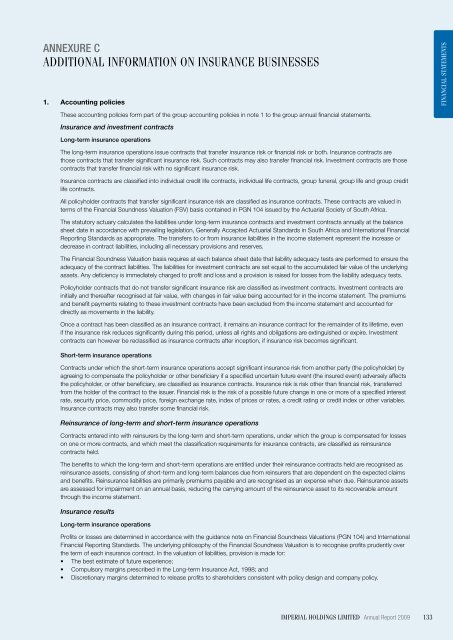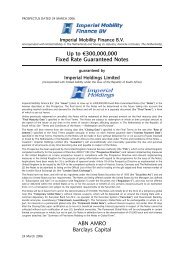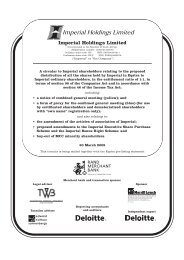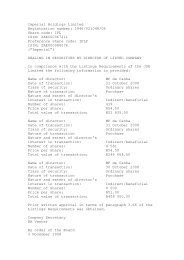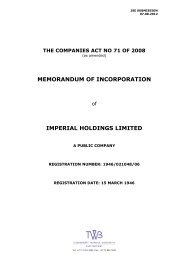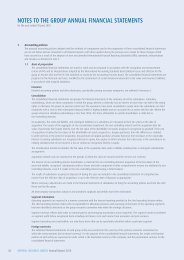4.0 - Imperial
4.0 - Imperial
4.0 - Imperial
You also want an ePaper? Increase the reach of your titles
YUMPU automatically turns print PDFs into web optimized ePapers that Google loves.
ANNEXURE C<br />
additional information on insurance businesses<br />
1. Accounting policies<br />
Financial Statements<br />
These accounting policies form part of the group accounting policies in note 1 to the group annual financial statements.<br />
Insurance and investment contracts<br />
Long-term insurance operations<br />
The long-term insurance operations issue contracts that transfer insurance risk or financial risk or both. Insurance contracts are<br />
those contracts that transfer significant insurance risk. Such contracts may also transfer financial risk. Investment contracts are those<br />
contracts that transfer financial risk with no significant insurance risk.<br />
Insurance contracts are classified into individual credit life contracts, individual life contracts, group funeral, group life and group credit<br />
life contracts.<br />
All policyholder contracts that transfer significant insurance risk are classified as insurance contracts. These contracts are valued in<br />
terms of the Financial Soundness Valuation (FSV) basis contained in PGN 104 issued by the Actuarial Society of South Africa.<br />
The statutory actuary calculates the liabilities under long-term insurance contracts and investment contracts annually at the balance<br />
sheet date in accordance with prevailing legislation, Generally Accepted Actuarial Standards in South Africa and International Financial<br />
Reporting Standards as appropriate. The transfers to or from insurance liabilities in the income statement represent the increase or<br />
decrease in contract liabilities, including all necessary provisions and reserves.<br />
The Financial Soundness Valuation basis requires at each balance sheet date that liability adequacy tests are performed to ensure the<br />
adequacy of the contract liabilities. The liabilities for investment contracts are set equal to the accumulated fair value of the underlying<br />
assets. Any deficiency is immediately charged to profit and loss and a provision is raised for losses from the liability adequacy tests.<br />
Policyholder contracts that do not transfer significant insurance risk are classified as investment contracts. Investment contracts are<br />
initially and thereafter recognised at fair value, with changes in fair value being accounted for in the income statement. The premiums<br />
and benefit payments relating to these investment contracts have been excluded from the income statement and accounted for<br />
directly as movements in the liability.<br />
Once a contract has been classified as an insurance contract, it remains an insurance contract for the remainder of its lifetime, even<br />
if the insurance risk reduces significantly during this period, unless all rights and obligations are extinguished or expire. Investment<br />
contracts can however be reclassified as insurance contracts after inception, if insurance risk becomes significant.<br />
Short-term insurance operations<br />
Contracts under which the short-term insurance operations accept significant insurance risk from another party (the policyholder) by<br />
agreeing to compensate the policyholder or other beneficiary if a specified uncertain future event (the insured event) adversely affects<br />
the policyholder, or other beneficiary, are classified as insurance contracts. Insurance risk is risk other than financial risk, transferred<br />
from the holder of the contract to the issuer. Financial risk is the risk of a possible future change in one or more of a specified interest<br />
rate, security price, commodity price, foreign exchange rate, index of prices or rates, a credit rating or credit index or other variables.<br />
Insurance contracts may also transfer some financial risk.<br />
Reinsurance of long-term and short-term insurance operations<br />
Contracts entered into with reinsurers by the long-term and short-term operations, under which the group is compensated for losses<br />
on one or more contracts, and which meet the classification requirements for insurance contracts, are classified as reinsurance<br />
contracts held.<br />
The benefits to which the long-term and short-term operations are entitled under their reinsurance contracts held are recognised as<br />
reinsurance assets, consisting of short-term and long-term balances due from reinsurers that are dependent on the expected claims<br />
and benefits. Reinsurance liabilities are primarily premiums payable and are recognised as an expense when due. Reinsurance assets<br />
are assessed for impairment on an annual basis, reducing the carrying amount of the reinsurance asset to its recoverable amount<br />
through the income statement.<br />
Insurance results<br />
Long-term insurance operations<br />
Profits or losses are determined in accordance with the guidance note on Financial Soundness Valuations (PGN 104) and International<br />
Financial Reporting Standards. The underlying philosophy of the Financial Soundness Valuation is to recognise profits prudently over<br />
the term of each insurance contract. In the valuation of liabilities, provision is made for:<br />
• The best estimate of future experience;<br />
• Compulsory margins prescribed in the Long-term Insurance Act, 1998; and<br />
• Discretionary margins determined to release profits to shareholders consistent with policy design and company policy.<br />
<strong>Imperial</strong> holdings limited Annual Report 2009 133


